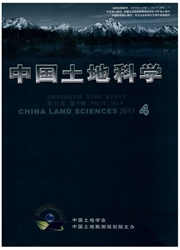

 中文摘要:
中文摘要:
研究目的:在工业园区开发建设的背景下,观察中国不同等级城市工业地价和产业升级的相互关系。研究方法:从城市维度将工业地价对产业升级的作用分解为促进效应和抑制效应,并运用三产品、多要素产业发展雁行模型,对35个已经大规模开展新城和园区建设的大中城市进行实证检验。研究结果:多数城市处于劳动密集型向中等资本密集型过度,且暂无资本密集型形成的阶段,即地价上涨带来了部分促进效应和完全抑制效应。只有深圳、南京、上海和北京4个城市已经出现由中等资本密集型向资本密集型转变的态势,但这几个城市的劳动密集型工业企业仍表现为增长趋势,即地价上涨同时带来了完全的促进效应和完全的抑制效应。研究结论:依据城市产业升级难易程度推进差别化的工业用地市场化供地机制,这其中基础性工作是根据城市主体功能定位、产业布局形态和土地使用权价值来综合评定基准地价。对于以劳动力密集型工业企业为主的部分二三线城市,还应允许工业企业适度的土地用途转变,激励企业前期固定资本积累以促进其产业升级。
 英文摘要:
英文摘要:
The purpose of this paper is to explore the relationship between industrial land price and industrial upgrading at city level in the context of China' s industrial park development in recent decades. Based on the theoretical analysis, i.e., industrial land price affects industrial upgrading from two aspects (the promotion effect and the inhibition effect), the method used in the paper mainly include the industrial development flying geese model of three-goods and two-cones. The paper aims to do the empirical test to identify which effect is stronger in the 35 big and medium-sized cities with large-scale industrial parks and residential communities. Results show that most of the cities are in the transition phase where the leading industries are in the transition period of labor-intensive to middle capital-intensive, and none is in the form of capital-intensive. The situation that the middle capital-intensive change to capital-intensive has only emerged in Shenzhen, Nanjing, Shanghai and Beijing, however the industrial enterprises belonging to labor-intensive are still show growth trend. It shows that the growth of land price not only brought complete promotion effect, but also resulted in the complete inhibition effect. The paper concludes that it is necessary to implement the different industrial land supply policy according to the difficulties of urban industrial upgrading. The key point for such task is to develop the benchmark land price system based on the main function of the city development, industrial land assignment, and the price of land use right. Furthermore, it is also necessary to permit the less-developed cities where the industries are mostly labor-intensive ones to change the industrial land use to other uses in more flexible way in the purpose of encouraging the upgrading of the industrial sector.
 同期刊论文项目
同期刊论文项目
 同项目期刊论文
同项目期刊论文
 期刊信息
期刊信息
